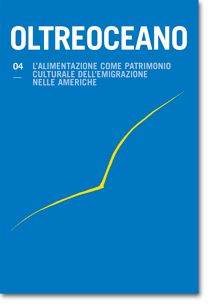Nutrire… il ricordo
Keywords:
Smolensky, memoria, emigrazione, integrazione ebreiAbstract
Lo studio analizza, attraverso l’opera dell’antropologa Eleonora M. Smolensky, fuggita bambina da Trieste con la famiglia a causa delle leggi razziali fasciste, la capacità degli ebrei di assimilare e, di conseguenza, di tramandare le loro molteplici appartenenze, nonché alla loro capacità di integrarsi, mantenendo però sempre viva la loro specificità identitaria.
To Nurture... Memories
By focusing on the works of Eleonora M. Smolensky, the anthropologist who escaped from Trieste as a child with her family because of the Fascist racial laws, this essay examines how the Jews were able to assimilate and thus hand down their multiple sense of belonging, but also to integrate while maintaining their specific identity.
Downloads
References
Cattarulla, C. & Magnani, I. (2004): L’azzardo e la pazienza. Donne emigrate nella narrativa argentina. Troina: Città Aperta.
De Luca, A.P. (2010): Aglio, la pianta più eloquente, con la grazia di un giglio: odori e sapori nella letteratura etnica canadese. In S. Serafin & C. Marcato (Eds.), L’alimentazione come patrimonio culturale dell’emigrazione nelle Americhe. Oltreoceano, 4, pp. 79-89.
Serafin, S. (Ed.): Ecos italianos en Argentina. Emigraciones reales e intelectuales. Pasian di Prato (Ud): Campanotto. 2008.
Finzi, P. , Toker, E. & Faerman, M. (Eds.) (1996): El imaginario judío en la literatura de América Latina. Visión y realidad. Buenos Aires: Shalom.
Frey Waxman, B. (2008): Food Memories: What They Are, Why They Are Popular, and Why They Belong in the Literature Classroom. College English, 70, 4, pp. 363-383.
Serafin, S. (Ed.) (2004): Immigrazione friulana in Argentina: Syria Poletti racconta… Roma: Bulzoni.
Lockhart, D. B. (2005): From Gauchos judíos to Ídishe mames posmodernas. Popular Jewish Culturein Buenos Aires. In M. Agosín (Ed.), Memory, Oblivion, and Jewish Culture in Latin America (pp. 177-206). Austin: University of Texas Press.
Giorcelli, C. & Cattarulla, C. (Eds.) (2008): Lo sguardo esiliato. Cultura europea e cultura americana fra delocalizzazione e radicamento. Casoria: Loffredo.
Macias Kapón, U. (2006): La cocina en las festividades judías. Estudios Mirandeses, 26, pp. 107-128.
Agosín, M. (Ed.), (2005): Memory, Oblivion, and Jewish Culture in Latin America. Austin: Universityof Texas Press.
Feierstein, R. & Shadow, S. A. (Eds.) (2002), Recreando la cultura judeoargentina. 1894-2001: en el umbral del segundo siglo. Buenos Aires: Milá.
Rocco, F. (2008): Los gringos de la Argentina: entrevista a la fotógrafa María Zorzon. In S. Serafin (Ed.): Ecos italianos en Argentina. Emigraciones reales e intelectuales (pp. 101-110). Pasian di Prato (Ud): Campanotto.
Serafin, S. (2004): Donna e emigrazione in Gente conmigo: simboli di una duplice proscrizione. In S. Serafin, (Ed.) Immigrazione friulana in Argentina: Syria Poletti racconta… (pp. 75-90). Roma: Bulzoni.
Smolensky, E. M. & Vigevani Jarach, V. (1998): Tante voci, una storia. Gli ebrei italiani in Argentina, 1938-1948. Bologna: Il Mulino.
Shua, A. M. (1994): El libro de los recuerdos. Buenos Aires: Sudamericana.
Shua, A. M. (1996): Retazos de recuerdos. In P. Finzi, E. Toker & M. Faerman (Eds.), El imaginario judío en la literatura de América Latina. Visióny realidad (pp. 20-23). Buenos Aires: Shalom.
Steimberg, A. (1983): Músicos y relojeros. Buenos Aires: Centro Editor de América Latina.
Steimberg, A. (1992): Cuando digo Magdalena. Buenos Aires: Planeta Argentina.
Steimberg, A. (1996): ¿Sabe que es linda la mar? In P. Finzi, E. Toker & M. Faerman (Eds.), El imaginario judío en la literatura de América Latina. Visióny realidad (pp.10-11). Buenos Aires: Shalom.
Steimberg, A. (2002): Escritores de aquí y de allá. In R. Feierstein & S. A. Shadow (Eds.), Recreando la cultura judeoargentina 1894-2001: en el umbraldel segundo siglo (pp. 123-127). Buenos Aires: Milá.
Toaff, A. (2000): Mangiare alla giudia. Bologna: Il Mulino.
Vellucci, S. (2008): Complicated Homecomings: le scritture nomadi di Sandra M. Gilbert e Louise DeSalvo. In C. Giorcelli & C. Cattarulla (Eds.), Lo sguardo esiliato. Cultura europea e cultura americana fra delocalizzazione e radicamento (pp. 487-507). Casoria: Loffredo.
Downloads
Published
How to Cite
Issue
Section
License

This work is licensed under a Creative Commons Attribution-NonCommercial-ShareAlike 4.0 International License.
The authors undertake to comply with the following conditions, which are considered accepted at the time of submission of their contributions.
The sending of a text implies that it is unpublished and not submitted to be published elsewhere.
1. If accepted, the author shall confer on the publisher the right to publish and distribute it both in paper form and in the online electronic edition. The published articles will be downloadable and made available in open access.
2. Provided that it correctly indicates that the first publication took place in the journal Oltreoceano. Rivista sulle migrazioni the author has the right to: a) reproduce the article in separate extracts or collected in a volume; b) publish the article on their personal website or teaching site provided that these sites are of a non-commercial nature; c) deposit the article in online archives of a non-commercial nature, linked to the institution they belong to or as part of projects for the non-commercial dissemination and open access of scientific works.
The use of contributions by third parties, for commercial or otherwise unauthorized purposes, is not allowed. The publisher declines all responsibility for the unauthorized use of the material published in the journal.












